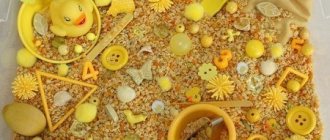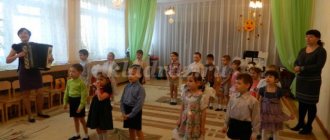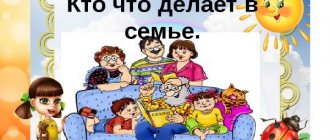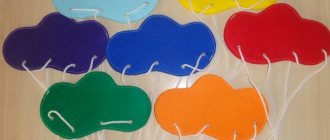How to play with a matryoshka doll in kindergarten
This famous toy can be used in kindergarten to teach counting and develop fine motor skills. Children are told riddles about the doll, learn rhymes, dance in circles and play games. You can build a whole lesson around a matryoshka doll. And in his script, use thematic music (folk and original), counting rhymes, riddles, and sayings.
There are many songs about the “Russian doll”. For example, “We are nesting dolls, these are the little ones”, “Matryoshka” (Yu. Verizhnikov), “Russian nesting doll” (folk song) and others. “Russian nesting dolls” on Youtube with 4.5 million views. I don’t really like it; the performers do not pronounce “S” and “Sh” clearly. I wouldn't want children to pick up this pronunciation.
There are a great many mysteries on this topic. For example, they can be taken from here and here . Children usually enjoy activities with a bright, eye-catching toy.
Important! Follow safety precautions when playing. It is better not to give babies a matryoshka “baby” the size of a fingernail; it can easily be stuck in the nose or ear. Small natural material for decorating flat matryoshka dolls is best given to children after 3-4 years of age.
By the way, wooden figurines are not the only form of matryoshka. You can play with other options. For example:
- We make fairly large flat blanks of nesting dolls from cardboard. Let's paint them.
- Children will decorate the blanks using modeling and natural materials. To do this, we distribute plasticine, peas, beans, and coffee beans.
- We show how to glue a plasticine base to a flat piece, and attach “decorations” in the form of grains and peas to it.
There are a lot of didactic games with Russian nesting dolls. For example, “Pick up a skirt,” when you need to assemble sets from a cardboard (or wooden) top and bottom. Or fun with rag nesting dolls, when they need to be folded in pairs, small ones in pockets next to large ones.
With the help of dolls you can study arithmetic. For example, this set of 5 traditional dolls will help. I’m just crazy about this children’s play set “Bunny” I also recommend the tutorial for the application “Funny Matryoshkas” . Suitable for children from 3 years old.
Features of folk crafts
The toy is made from linden, birch or alder. The workpiece is polished and primed. It is painted by the artist with a variety of paints: aniline, oil, gouache. The last option is the most popular. Then the detachable dolls are opened with varnish. Usually there are 6-8 of them in one set. Although there are options for 25 or more pieces. The completeness depends on what the author came up with and his skill.
The largest Russian nesting doll was made in Semenov. Or rather, one set consisting of 56 dolls. The first matryoshka has a height of about a meter, the last is no more than a pea. According to other sources, Semyonov craftsmen made a set of 72 figures for the Expo 1970 exhibition in Tokyo. We must pay tribute to the Chinese too. In one of the country's amusement parks there is a giant matryoshka doll 30 m high. This is not a toy, but a building with an area of 3200 m². An overgrown matryoshka was included in the Guinness Book of Records.
In our country there are several museums that allow us to trace the history of the traditional painted nesting doll. For example, the exhibition in Semenov presents decorative dolls from Russian craftsmen from different regions. There are museums in Moscow, Kalyazin, Nizhny Novgorod, Sergiev Posad, Voznesensk.
Matryoshka dolls have become the most popular Russian souvenir in the world. They are gladly taken abroad as gifts and for collectors. 60% of Semenovsk products are exported. The secret is simple. The doll is an example of folk talent, often simple-minded, but multifaceted. She is amazing and unique. The fishery gained worldwide fame in 1900, when it won a medal at the World Exhibition in Paris. And 5 years later, a nesting doll shop opened in this city.
Russian matryoshka at home and in kindergarten
Several generations of children enjoyed playing with the doll. Nowadays games are a bit of a thing of the past. But in vain, the detachable figurine has a huge developmental effect. It is environmentally friendly and safe for children. Develops movements, perception, tactile sensations and mental abilities, trains the muscles of the fingers. The toy can be recommended as one of the first in a baby’s life.
With the help of figures you can explain the concepts of “big and small”. With them, the child learns to play role-playing games - in a family with a mother and several children. To prevent the baby from losing interest, it is better to hide the nesting doll after playing. There are many games, they are divided according to the age of the children. For example, babies under 1 year old will be interested in the following:
- We teach the child to open and close the halves. Be surprised and happy when there is something inside.
- We show that the halves should fit each other. If this is not the case, the pupa will not be collected.
- We voice: “The baby nesting doll is scared, she needs to be hidden in a larger doll.” Let the child figure out what to invest where.
- When the baby is not in the room, we place the toys in a visible place. And then we ask him to find the lost sisters.
With the help of figures you can teach children 2-3 years old. There are more games for them. Eg:
- We suggest arranging the dolls by height, let them go somewhere. When they go in the opposite direction, let them line up in the reverse order.
- We arrange toys according to height and forget one. Let the baby put it in place.
- We trace the bases of the nesting dolls on paper. These will be the “chairs” around the table. We ask the child to seat the dolls on chairs.
- If there are two sets of nesting dolls, you can mix them and ask your child to sort them. An option is to arrange them in pairs according to height.
- We explain the concepts of “higher-lower”, “more-less”, “inside-outside”, “right-left”. And then we ask questions on the topic, placing the nesting dolls in different ways.
For older children, toys help develop creativity. The blanks can be painted. Games for children 3-4 years old:
- Let's learn to count. We put beads inside the nesting dolls and write the quantity on the bottom. Then with the child we count how many there actually are.
- We play out role-playing situations (in the family, on the playground, etc.).





